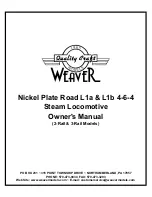
The ‘Paint Job’
Occasionally customers notice certain problem areas with composite parts.
But the question is: Are these real problems, or are they just a misunderstood sign of high-tech
construction, proving the high-end composite technology?
Seams:
ALL composite parts have seams.
They are there today, and they will
be there forever. You will have to get
used to them ... or you’ll have to
touch up the paint yourself !
But what is a seam? A seam on the
fuselage, especially already painted
in the mould, proves that this is a
vacuum-bagged high-tech part,
made in negative moulds. Our
seams are fine and straight, no neg-
ative impression at all ... but they are
there. When possible we include
5mm wide strips of self-adhesive
vinyl, painted in exactly the same
colour as the plane for you to cover
the seams if you want.
Paint flaws:
If the aircraft is painted in the
moulds, you can save a lot of
weight. At least 2 lbs ... and that is
definitely worth saving !
A negative paint job is very compli-
cated to make. The painter never
sees the result of his job. He cannot
see the design growing and devel-
oping - he is painting ‘blind’. He
even cannot see little mistakes and
flaws, and even if he COULD, he
could not correct them. The maxi-
mum time to apply a designer paint
scheme in the mould is no more
than 20 minutes. It is a big rush
against time, because even if it is
just few minutes too slow then the
masking cannot be removed without
pulling off the paint itself ! This is a
BIG challenge, but the result is
extraordinarily impressive. Even
with slight flaws the general appear-
ance of these one-of-a-kind paint
jobs is unique.
Composite-ARF Yak-55 SP
(2.6m span)
8
(above) An example of one of our big Yak-55’s in the
honeycomb ‘limited’ edition’ scheme ... all painted in the
moulds !
(below) One of our customers with the 3.3m Yak-55SP
practising his tail-in hovering on a very windy day !












































